For the second year, Aspect’s Senior Remediation Engineer, Adam Griffin, spoke to the AP Environmental Science class at Franklin Pierce High school in Tacoma. Adam told the students about the variety of ways he applies science and engineering every day in his professional life and said, “I left energized and encouraged by the next generation’s awareness.” Many of these students have already been accepted into college and are pursuing science and engineering fields. Way to go Adam and best wishes to the Franklin Pierce students!
Tim Flynn Spoke on Aquifer Storage and Recovery at the ASCE Seattle Meeting
Aspect's Tim Flynn was invited to speak about Aquifer Storage and Recovery at The American Society of Civil Engineers (ASCE) Seattle Section luncheon. Tim provided an overview of ASR, including objectives, applications, and regulatory permitting process, as well as several case studies.
Aspect Wenatchee in the News
Wanting to learn more about our growing North Central Washington team, the Wenatchee World profiled Aspect's Wenatchee staff.
Water, earth, science: Elements combine for Aspect's success
by Mike Irwin | April 25, 2016
WENATCHEE — The 9-foot-deep dry well at curbside overflowed with water after every hard rain. Runoff backed up, flooded the street, blocked driveways and pooled in yards. Homeowners resorted to sandbagging during the steadiest downpours.
“The water is supposed to drain into the hole and slowly seep into the surrounding soil,” said Bill Sullivan, senior hydrologist and team leader for the Wenatchee office of Aspect Consulting, a soil-and-water consulting firm. “Our job is to figure out why that’s not happening.”
Finding a solution to the slow-draining dry well on Harris Court in northwest Wenatchee is just one practical example of Aspect’s expanding reach into the earth-and-water issues faced by North Central Washington homeowners, farmers and businesses.
From investigating water rights to developing public well systems to evaluating fire-damaged properties to helping improve water flow in Leavenworth’s Icicle Creek, Aspect has grown its client list to include municipalities, government agencies, private industries and homeowners — anyone who faces a water-soil problem solved by science and engineering.
“Real people, real problems,” said Taylor Dayton, one of the company’s water resources engineers in Wenatchee. “That’s what attracted me to this job — being out in the field at the site of the problem, helping people figure out what’s wrong and how to fix it.”
Founded on Bainbridge Island in 2001, Aspect Consulting now has 70 employees at five office locations around the state. For the most part, Aspect focuses in four key areas: water resources, environmental services, geotechnical engineering and data mapping services.
In Wenatchee, Aspect employs three scientists and four engineers to tackle scores of projects every year from the Canadian border to the Yakima River basin. Sullivan opened the Wenatchee office in 2008 with fellow water resources engineer Ryan Brownlee, and they’ve seen the staff grow with their project list.
“It may seem obvious,” said Sullivan, “but we’ve grown because we do good work and have won a fair share of the market.” He said Aspect staffers approach jobs — some controversial due to environmental issues — “in an objective manner with no agenda. We like to think that for many people and agencies, we’ve become a trusted adviser.”
Plus, Sullivan said, hydrologists and geotechnical engineers find NCW fascinating place to work. “We’re at an intersection of natural resources,” he said, “where mountains, rivers, desert and varied geology all come together. The problems that arise can be challenging — that’s for sure — but that’s also what makes them interesting.”
Recent projects have addressed slope instability, structure foundations, retaining walls, bridge replacements, water storage and “banking” for future use, fixing broken water meters, monitoring aquifers, habitat restoration, the effects of drought on irrigation and fish habitat and a wide array of services concerning water rights.
On that last topic, “we try to help our clients figure out if water is physically available, then if it’s legally available,” said Bracken Capen, an Aspect civil engineer in Wenatchee.
“At the end of the day,” said Sullivan, “we’re problem solvers. Science is part of our job. Engineering is part of it. Communicating in straight-forward language is a big part of it, too. The solutions we find have to make sense to the people we work for.”
As for that slow-draining dry well in northwest Wenatchee? “It’s pretty much what you could expect,” said Sullivan. “The changing urban watershed draining into this dry well can produce build-up at the bottom and silting in lateral drains. For right now, the easy solution is to rehab the well, which means cleaning it out to make it better.”
Rebuilding Around the World: Henry Haselton’s Ongoing Volunteer Work
Principal Geotechnical Engineer Henry Haselton is providing pro bono engineering services to help rebuild and protect schools, villages, and farms affected by natural disasters in Nepal and Tanzania.
Henry has been working with All Hands Volunteers to rebuild schools that were destroyed after the massive earthquake in Nepal in April 2015. Most recently, he helped with site development and foundation recommendations for the East Point Academy in Melamchi, which is about 25 miles north of Katmandu. The Nepalese government prepared standard school designs, and they need engineering help to make the structures work at particular locations. He also designed an earthquake-resistant retaining wall to support the school in its new location. Henry is now embarking on work for another school project higher up in the Himalayas.
photo courtesy of All Hands Volunteers
Earlier this year, Henry provided geotechnical consultation for a sugar cane producer who is affiliated with a non-governmental organization south of Moshi, Tanzania to help alleviate flooding of villages and farms in the area. The engineering work was led by master’s students from Tu Delft in the Netherlands. Henry’s work focused on extending levees and installing weirs to mitigate flooding, and included recommendations on geotechnical field and laboratory testing, slope stability analyses, and general geotechnical recommendations for the levees.
Too Much Flare, Not Enough Gas
Aspect’s Peter Bannister, along with King County’s Dan Swope, will co-present at the 2016 Solid Waste Association of North America (SWANA) Northwest Regional Symposium in Vancouver, BC on Friday April 8th.
As landfills age and landfill gas generation inevitably declines, landfill operators face the problem of using legacy collection and control systems that weren’t designed to harvest dwindling amounts of landfill gas. Simply continuing operation of these oversized systems is often not practical or financially prudent.
Peter and Dan will present the Enumclaw Landfill case-study and focus on how landfill gas forensics has proven to be an innovative solution to coaxing better performance out of existing landfill gas collection and control systems, and designing downscaled systems, at closed landfills in King County, Washington State.
Peter and Dan will present Friday morning at 10:30AM in technical session 6B – Advances in Landfill Gas Management. Learn more about the conference HERE and view the agenda HERE.
We look forward to seeing you there!
Environmental Data Management Done Right: EQuIS in Action
Aspect’s Data + Mapping team uses time-saving tools to streamline our data analysis and processing to inform conclusions, design, and reporting—at the center of which is the environmental data management system EQuIS. Having long been leaders in the field of environmental chemistry data management, we have recently migrated from home-built, custom database systems to this industry standard. Our expertise with this powerful software has been bolstered by Senior Staff Data Scientist Lea Beard, who joined Aspect last summer. She is an EQuIS expert who turns her deep analytical chemistry and data management skills into efficiencies and insights for Aspects project teams and clients.
Why we use EQuIS:
- It is reliable and stable, ensuring the integrity of our clients’ valuable data.
- It helps us to process, review, manage, and analyze data as rapidly as our projects move.
- It enables us easily tailor reporting outputs to the nuanced needs of a project.
- It ensures adherence to standards and helps us to maintain consistency across projects.
- It safeguards our data’s compliance with environmental regulatory standards.
Created by EarthSoft, EQuIS is optimized to handle a broad-range of environmental data—particularly environmental chemistry data. EQuIS gives us the “brain” to formulate answers to the questions its users may ask, such as:
- How many fish passed through this culvert last year?
- To what extent have the concentrations of chlorinated solvents in groundwater responded to the remediation system operation?
- Was the Reporting Detection Limit for Lead low enough to meet the Quality Assurance Project Plan?
- What were water level elevations in this monitoring well network from 2010 to 2015?
Having this framework already in place saves us and our clients time and money that would otherwise be spent building or customizing software to meet ever-changing needs. EQuIS also contains built-in solutions for common problems encountered in environmental reporting. It’s been put to the test by a wide cross-section of users—consultants, public agencies, corporations, laboratories—who have contributed their feedback and worked out bugs as they go. With a diverse group of users informing how it works for them, EQuIS is able to keep up with the state of environmental reporting.
Case Study in How EQuIS Simplifies Our Data Collection
Our staff heads out to a project site, tablet loaded with Fulcrum in hand, and begins to collect data. When the day is done, they send samples to the lab for analysis. Taking the field observations and measurements from Fulcrum and the analytical results from the lab, Lea feeds these two data sets alongside one another into EQuIS. With these normally separate datasets stored together in one spot, EQuIS makes it easy to access and search. Automated alerts and reporting based on preset parameters (perhaps a particular contaminant level has been detected or exceeded) means that project teams can make timely decisions about their next round of data collection or further investigation/inquiry. Reversing the direction of the data, Lea can then feed those results back into Fulcrum, sending it out to the team in the field, ensuring they have the most up-to-date information at the site. In the past this information exchange would have taken a week, but with EQuIS and Fulcrum, it takes mere hours.
EQuIS weaves together the data streams and creates meaningful output.
A Helping Hand Sets Clients on the Right Data Management Path
While EQuIS has the power and flexibility to make managing data easy, it can be a bit daunting to learn and implement. Lea helps guide clients through the set-up process – deciding on reference values, figuring out which lab electronic data deliverable formats to use, building reporting standards – forming the framework of their ongoing data management needs. From there, Aspect can help clients create software customizations to make summing groups of analytes (such as polychlorinated biphenyls) straightforward and reproducible, and offer assistance on making data easy to export into Ecology’s Environmental Information Management (EIM) database. Our in-house experience with EQuIS allows us to help clients tell their project’s story clearly.
Having someone like Lea at the helm of a program like EQuIS allows us to efficiently collect, manage, and report on data, ensuring that the rest of our team can focus on what they’re best at: science and strategic advice for our clients.
Meet Adam Griffin
Aspect is excited to welcome Adam Griffin to our Environmental team. He recently joined us as a Senior Remediation Engineer working from our Bainbridge Island office. Adam has 10 years of remediation experience across the country and internationally, supporting projects in Europe and South America. His experience is focused on the design and implementation of in-situ remediation approaches at commercial, industrial, and mining sites. Adam received his B.S. and M.S. degrees in environmental engineering from the University of Tennessee and has worked in the Northwest for five years.
As part of his introduction to Aspect, Adam hosted a technical exchange for the staff. The presentation highlighted his broad experience with in-situ remediation technologies, or the cleanup of contaminated media in place as opposed to pumping or removal for aboveground treatment. Every site’s conditions are different, and therefore developing a sound Conceptual Site Model (CSM) allows the “tuning” of in-situ remediation technologies for successful implementation. Adam shared examples of unique site conditions, such as soil geochemistry, high-flux aquifers, and stratigraphic constraints, and then explored how to tailor an approach and design to allow successful implementation of the selected technologies. He walked us through five case studies spotlighting some of these methods that have led to successful site remediation.
When he’s not contemplating aquifer conditions or remediation geochemistry, Adam enjoys camping and kayaking around Western Washington, accompanied by his wife and their two dogs.
2015 - It's Been a Great Year!
A Look Inside Vapor Intrusion
When volatile chemicals have the potential to migrate from contaminated groundwater or soil into an overlying building—i.e., vapor intrusion (VI)—a whole new layer of complexity is added to environmental remediation projects. In Washington State over the last several years, vapor intrusion has been under increasing regulatory scrutiny. An understanding of vapor intrusion typically revolves around a few core questions:
- How to accurately evaluate it?
- How to keep abreast of what’s required, given that the regulatory guidance is constantly evolving?
- How to protect human health during and after site cleanup?
During Aspect’s monthly technical exchange series, Eric Marhofer, Dave Heffner, Carla Brock, Eric Geissinger, and Kirsi Longley of our environmental team gave a roundtable presentation of their collective experience at assessing vapor intrusion at well over 100 sites.
Read MoreGIS Day Roundup
Aspect commemorated GIS Day, a part of Geography Awareness Week, with a spirited celebration featuring maps, trivia, and cake.
The festivities kicked off with a presentation by Senior Data Scientist Parker Wittman, highlighting some of the GIS team’s work over the last year. They have developed innovations using Fulcrum in concert with Google Earth, EQuIS, and other software to make field testing, sampling, and reporting much more efficient. Citing specific work Aspect has done for the Port of Seattle at SeaTac Airport, Parker demonstrated how the systems we’ve created are helping the Port assess the potential impacts proposed construction/redevelopment would have on the existing stormwater infrastructure and keep the existing mass of ever-updating data organized and easily accessible. Our team is strategically employing automated tools where it can save projects time and money.
Later in the day, we cut the cake as the GIS team set out to stump the rest of us with several rounds of GIS / geography-related trivia questions.
- List the eight states and provinces that the entire Columbia River Basin lies within.
- What two countries provide full satellite coverage of the Pacific Northwest?
- If you live in this city in Washington State, you must cross through two international borders to drive your car to any major shopping areas.
- What is the comprehensive name of the interconnected seas, sounds, and bays in the Pacific Northwest?
- Bruce Springsteen's song "Streets of Philadelphia" won a Grammy and what other major award?
Of course, a GIS Day celebration would not be complete without an informative map. The GIS team polled staffers on all the places they’ve lived throughout their lives. Using the analytical software Tableau, they created this lovely lattice crisscrossing the world.
Tim Flynn to Talk Water Right Strategies for Irrigators at the 2015 WSWRA Spokane Conference
Over December 2-4, the Washington State Water Resource Association’s (WSWRA) annual conference in Spokane will bring together experts and public policy leaders to discuss important 2016 water issues, including climate change, drought response, and many other relevant irrigation topics. Aspect’s president and principal hydrogeologist Tim Flynn will present on day one of the conference in the Irrigation District Workshop. His presentation on “Recent Case Studies of Effective Water Right Strategies to Support District Operations” will examine irrigation district’s potential risks and opportunities and highlight case studies of the White Salmon and Methow Valley Irrigation Districts. Learn more about the conference HERE.
New Geologic Map Unveils Port Ludlow's Underground
Aspect Staff Geologist Jesse Favia is a co-author of the recently published geologic map of the Port Ludlow area in Kitsap and Jefferson Counties. The map—officially the Geologic Map of the Port Ludlow and southern half of the Hansville 7.5-minute quadrangles, Kitsap and Jefferson Counties, Washington, Map Series 2015-02 by M. Polenz, J. G. Favia, I. J. Hubert, G. L. Paulin, and R. Cakir— was a joint effort between the Washington State Department of Natural Resources (DNR) and the United States Geological Survey. Much like a dictionary is an official reference point for language, geologic maps are the official references in the field of geology, and it is thought an honor to have a hand in creating one.
Jesse worked on the map through an internship with Michael Polenz at DNR. They started in July of 2014, when Jesse, Michael, and Ian Hubert set out to map the quadrangle, which covers Port Ludlow and about 50 square miles around it that includes parts of Kitsap and Jefferson County. The group spent the summer exploring the land—sometimes in a truck on rural roads, sometimes on foot through the forest, sometimes by boat floating by bluffs on the coastline. They looked for cut banks and slopes, any place where soils were exposed and allow them a peek below the ground surface. Some days were slow; some days they’d stumble upon a huge exposure where the layers of soil deposits were clearly visible and they could easily take samples to date and analyze.
When fall arrived, Jesse spent from November 2014 to May 2015 in Olympia conducting the “mini science experiment” that would ultimately make the map. They ran lab tests on the approximately 200 soil samples they collected, worked with DNR’s editing section to display the deposits, and wrote the corresponding report.
The result of their efforts created an updated geologic map that will be used by everyone from government agencies to local engineering firms to inform them about what’s underground around Port Ludlow.
Click image below for full resolution.
Dan Haller to Present on Water Right Mitigation at Seattle Law Seminar on November 6
Aspect’s Dan Haller will speak on a panel to discuss water rights mitigation at the 8th Annual Water Rights Transfers Seminar in Seattle.
Mitigation—i.e., offsetting impacts from a new water right by either trading water (in kind mitigation) or providing habitat improvement or investment (out of kind mitigation)—is THE topic in Washington water circles because of the Washington State Supreme Court’s recent Foster vs. Ecology decision. This groundbreaking ruling overturned Ecology’s permit approval, thus cancelling the City of Yelm’s water right permit. This timely panel discussion will discuss recent case law and what it means for future water right permitting strategy.
Learn more or register for the conference HERE.
Duwamish Alive!
Last Saturday morning, a small fleet of kayaks gathered on the shore at Seattle’s Terminal 107 Park, slipped into the Duwamish River, and spread out in search of garbage. Aspect’s Mark Bruce and Steve Germiat were aboard two of them as part of the Duwamish Alive! biannual restoration and cleanup event.
Mark, Steve, and other volunteers plucked 286 pounds of litter and debris from the river itself. A total of over 400 volunteers on land at other sites along the river cleared blackberry, knotweed, nightshade, and other invasive weeds from 18,870 square feet of restoration area and planted 40 plants, including 12 trees.
The cleanup was led by the Duwamish Alive Coalition, a collaboration between local nonprofits, municipalities, and businesses within the Duwamish River Watershed that work to preserve and enhance its ecological health. This was the 10th anniversary of the Duwamish Alive! restoration events. Aspect staff have participated since 2012.
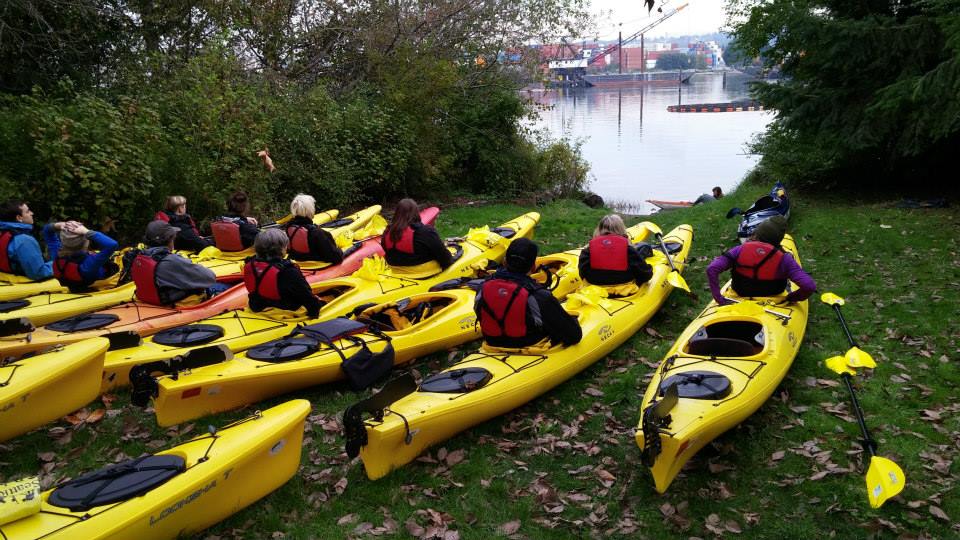
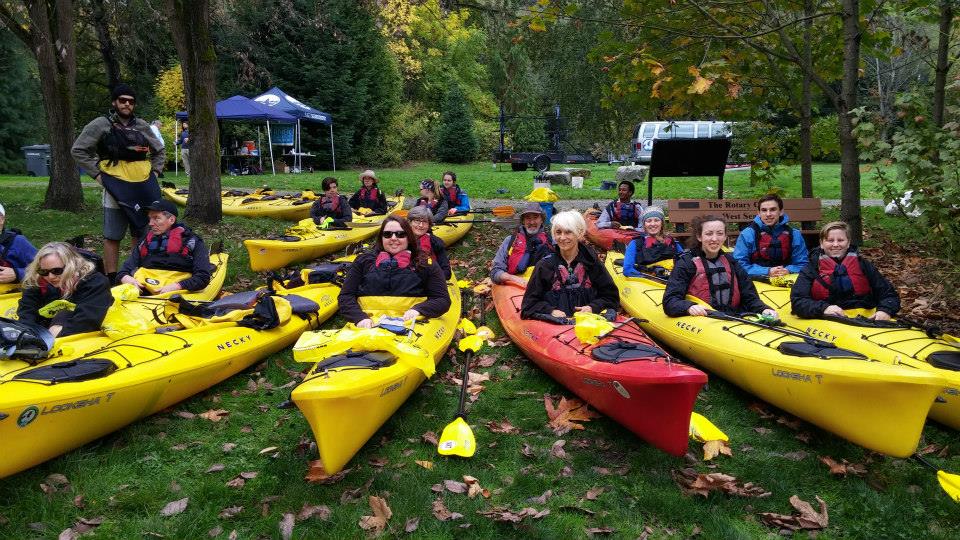
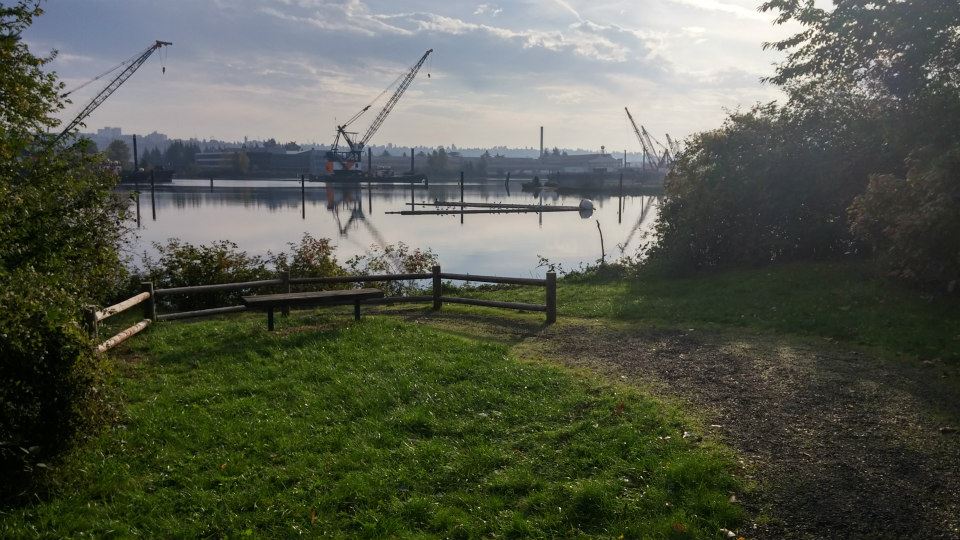
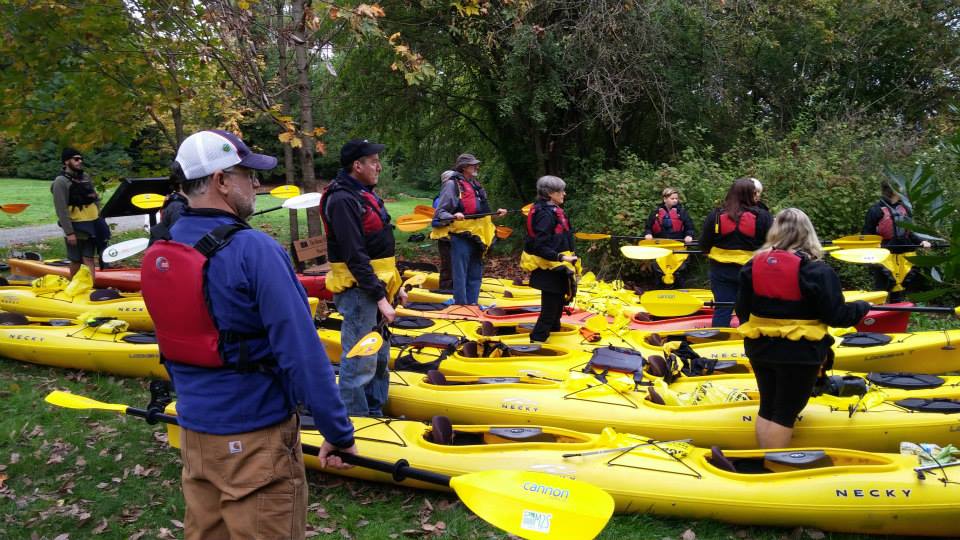
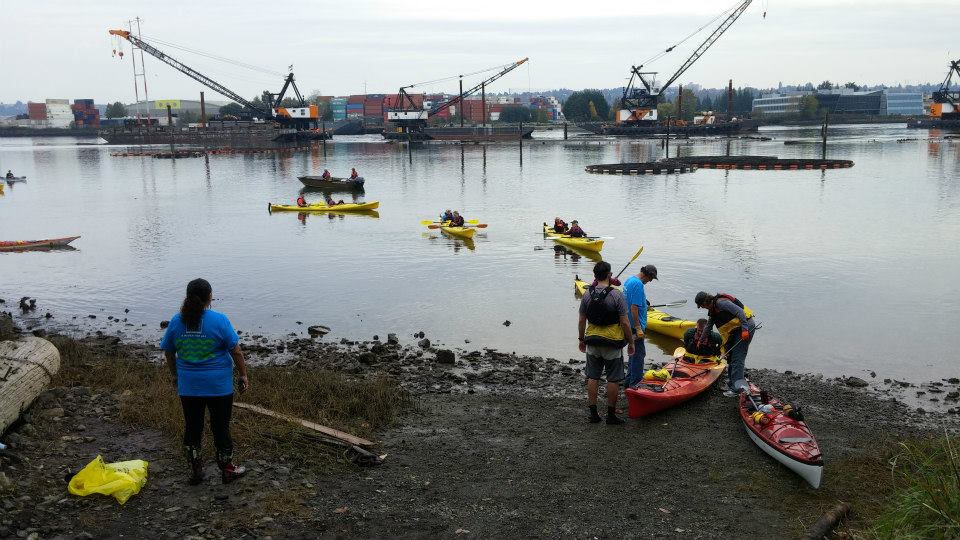
We’re Gonna Need a Bigger Port
The Port of Tacoma is preparing to berth some of the biggest ships in the world. Container ships are quickly outgrowing the U.S. ports that serve them – a trend that shows no sign of slowing down. These enormous container ships enable liners, shippers, and cargo owners to ship more goods at a lower unit cost. The newest of these ultra-large container ships carry more than 18,000 TEUs (20-foot equivalent unit containers), significantly exceeding Panamax dimensions (i.e., the largest ones that can pass through the Panama Canal, about 4,000 TEUs in 1985 and about 12,500 TEUs planned in 2015). These ultra-large container ships currently serve only the Asia-Europe trade routes, and exceed the capacity of U.S. ports. The average size ship calling on U.S. ports is still below 6,000 TEUs, but California ports have begun berthing 12,000 to 14,000 TEU ships. The increasing size of these ships puts pressure on ports to remodel, and fast, or else lose business to a competing port. Ports need to modify their channels and piers to accommodate these behemoths and upgrade their infrastructure to quickly unload, stage, and transport these containers to the hinterlands. See the trend in Vessel size over time in the graphic below.
Source: Sisson, M. (2013). “Impact and Opportunities from Global Change.” Presented at AAPA Facilities Engineering Seminar on November 6, 2013
The Port of Tacoma is redeveloping the Husky Terminal to allow the simultaneous berthing of two 18,000 TEU ultra-large container ships, which are about 1,300 feet long and 205 feet wide. This project involves the reconfiguration and construction of Pier 4 to align with Pier 3, creating a 2,954 feet long pier that can accommodate up to six 100-foot cranes capable of loading ships that are 24 containers wide. The project enables the Port of Tacoma to be one the first U.S. ports capable of berthing these ultra-large container ships, allowing the port to remain an economic engine for the Pacific Northwest.
Although a natural deep water port, this project involves the dredging of approximately 500,000 cubic yards of sediment, including about 45,000 cubic yards of tributyltin (TBT) contaminated sediment that will be dredged during Phase I of the project. TBT is a marine biocide that was commonly used in ship paint to kill mollusks, but is now globally banned. Aspect engineers Alan Noell and Tom Atkins worked with lead-engineering firm KPFF to evaluate TBT treatment technologies and to design a water treatment system capable of treating millions of gallons of TBT-contaminated dredge return water. Phase I of the project is currently underway with scheduled completion by April 2016, and soon after, the Port will move towards completing Phase II and begin berthing these ultra-large container ships.
Tim Flynn Sits on Scientific Risk Management Panel at the 24th Annual Water Law in Washington Conference
In late July 2015, the Washington Water Law Conference brought together water law practitioners, water users, and other experts to discuss current issues in Washington State’s water law. Aspect president and principal hydrogeologist Tim Flynn participated in a joint panel presentation on “Science vs. the Precautionary Principle: In what areas can more study lead to different decision making?” The presentations explored the technical and regulatory policy implications of reduced data collection and basic science in a resource constrained era on water right decisions. The precautionary principal was illustrated through case studies of established instream flow rules and the challenges associated with limited stream flow data particularly in snow-pack driven watersheds such as the Methow River Basin. Topics covered by other panelists included integrated water resource management issues and Ecology’s water right decision framework.
Aspect in the DJC: Weighing Ecology’s New Cleanup Guidance for Petroleum Sites
In a guest article in the Daily Journal of Commerce, Aspect’s Steve Germiat weighs in on the vision and the reality of the Washington State Department of Ecology’s new “model remedies” guidance for cleaning up petroleum-contaminated sites. This guidance proposes a kind of “pre-approved” shortcut to site cleanup. Steve goes into both the vision and the reality of this new (to Washington State) cleanup concept and its implications for site owners and developers.
Dan Haller to Speak at the October 2015 Osoyoos Lake Water Science Forum
Aspect’s Dan Haller will join other water experts on a panel to talk about British Columbia versus Washington water supply and management. The Forum will focus attention on sustaining the ecological health of Osoyoos Lake, along with the related well-being of the Okanagan Basin on both sides of the border. Learn more about the Water Science Forum HERE.
Aspect on the Radio
Geologic Issues for Developers and Homeowners
Dave McCormack, Aspect’s Senior Associate Engineering Geologist, was a recent guest on Alternative Talk 1150AM KKNW’s Condo & HOA Buzz. Hosts Duncan Kirk and Marshall Johnson quizzed Dave on the role an engineering geologist plays in building construction, development, and assessment to advise design teams on the best method for construction. They explored a number of geologic issues that can cause hassles for condo and Homeowner Association (HOA) dwellers—like eroding slopes, cracked foundations, seeping stormwater, and, of course, earthquakes—and how they can be addressed.
Listen to the full show in the Condo & HOA Buzz archives (select the August 5, 2015 show, the interview starts at the 5 minute 30 seconds mark).
Our Growing Yakima and Wenatchee Presence
Aspect continues to build our Yakima and Wenatchee team with the additions of new hires Meghan O’Brien, Project Scientist, and Taylor Dayton, Staff Engineer. We are excited to welcome Meghan and Taylor to Aspect and increase our engineering and water resources capabilities for our Eastern Washington clients.
Meghan O'Brien
Taylor Dayton
Working from our Yakima office, Meghan will join Aspect’s statewide-recognized water rights team to help our agricultural, municipal, and business clients manage and preserve their water. Meghan brings nearly 10 years of water right permitting experience, as well as relationships with many Washington clients and stakeholders Aspect works with every day. With prior experience working for the Washington State Department of Ecology, Meghan has valuable insight into the regulatory framework and permitting process that is key to successful water rights management. When not focused on water rights Meghan enjoys gardening, hiking and spending time with her family.
From Aspect’s Wenatchee office, Taylor will strengthen Aspect’s engineering capabilities for the planning and design of water, wastewater, and stormwater projects. Taylor supports her recently completed MS in Civil and Environmental Engineering with research experience at NASA. Taylor is an avid outdoor sports enthusiast relocating from the east coast to central Washington. Having only lived in the Mid Atlantic area she is looking to explore all the fantastic mountains and waterways that Washington has to offer.











